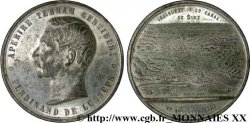v20_1277 - ÄGYPTEN - SUESKANAL Médaille en étain de l’inauguration du canal de Suez
MONNAIES 20 (2004)
Startpreis : 110.00 €
Schätzung : 250.00 €
Erzielter Preis : 110.00 €
Startpreis : 110.00 €
Schätzung : 250.00 €
Erzielter Preis : 110.00 €
Type : Médaille en étain de l’inauguration du canal de Suez
Datum: 1869
Metall : Zinn
Durchmesser : 49,5 mm
Stempelstellung : 12 h.
Graveur Angelo Restelli
Gewicht : 44,35 g.
Rand lisse
Seltenheitsgrad : R1
Kommentare zum Erhaltungszustand:
De petites marques de manipulation avec le brillant de surface de l’étain en partie absent des zones en relief. Très bel exemplaire
N° im Nachschlagewerk :
Vorderseite
Titulatur der Vorderseite APERIRE TERRAM GENTIBUS/ * FERDINAND DE LESSEPS *.
Beschreibung Vorderseite Tête à gauche de Ferdinand de Lesseps, signature A. RESTELLI sur la tranche du cou.
Rückseite
Titulatur der Rückseite INAUGURATION DU CANAL/ DE SUEZ/ 17 NOVEMBRE 1869.
Beschreibung Rückseite Vue aérienne de la région du canal à partir de la mer Rouge, au fond la mer Méditerranée ; à l’exergue signature A. RESTELLI F. TURIN.
Kommentare
La possibilité de faire un canal entre la mer Méditerranée et la mer Rouge fut démontrée dés 1841. Ferdinand de Lesseps, bénéficiant de l’amitié du vice-roi Saïd Pacha, entreprit la réalisation du projet. Ayant obtenu une concession de quatre-vingt-dix-neuf ans, il fonde la Compagnie universelle du canal de Suez avec 400.000 actions de 500 francs souscrites pour plus de la moitié par des Français. Les travaux commencèrent en 1859 mais s’interrompirent en 1863 sous la pression anglaise. L’intervention de Napoléon III sauva l’entreprise et les travaux recommencèrent en 1866. Le 17 novembre 1869, le canal était inauguré en présence de l’impératrice Eugénie, de l’empereur François-Joseph, des princes héritiers de Grande-Bretagne et de Prusse, d’Abd-el-Kader. Long de 162 kilomètres, le canal abrégeait de 8000 kilomètres le trajet Londres-Bombay. En 1888, le canal reçut un statut international et devait désormais être ouvert à tous en temps de paix ou de guerre, ce qui ne fut pas toujours respecté notamment lors des deux Guerres mondiales.
The possibility of building a canal between the Mediterranean Sea and the Red Sea was demonstrated as early as 1841. Ferdinand de Lesseps, benefiting from the friendship of Viceroy Said Pasha, undertook the project. Having obtained a ninety-nine-year concession, he founded the Universal Suez Canal Company with 400,000 shares of 500 francs, more than half of which were subscribed by French citizens. Work began in 1859 but was interrupted in 1863 under English pressure. The intervention of Napoleon III saved the enterprise and work resumed in 1866. On November 17, 1869, the canal was inaugurated in the presence of Empress Eugenie, Emperor Franz Joseph, the crown princes of Great Britain and Prussia, and Abd-el-Kader. At 162 kilometers long, the canal shortened the London-Bombay journey by 8,000 kilometers. In 1888, the canal was granted international status and was to be open to all in times of peace or war, a status that was not always respected, particularly during the two World Wars.
The possibility of building a canal between the Mediterranean Sea and the Red Sea was demonstrated as early as 1841. Ferdinand de Lesseps, benefiting from the friendship of Viceroy Said Pasha, undertook the project. Having obtained a ninety-nine-year concession, he founded the Universal Suez Canal Company with 400,000 shares of 500 francs, more than half of which were subscribed by French citizens. Work began in 1859 but was interrupted in 1863 under English pressure. The intervention of Napoleon III saved the enterprise and work resumed in 1866. On November 17, 1869, the canal was inaugurated in the presence of Empress Eugenie, Emperor Franz Joseph, the crown princes of Great Britain and Prussia, and Abd-el-Kader. At 162 kilometers long, the canal shortened the London-Bombay journey by 8,000 kilometers. In 1888, the canal was granted international status and was to be open to all in times of peace or war, a status that was not always respected, particularly during the two World Wars.








 Berichten über einen Fehler
Berichten über einen Fehler Die Seite drucken
Die Seite drucken Teilen meiner Auswahl
Teilen meiner Auswahl Stellen Sie eine Frage
Stellen Sie eine Frage Einlieferung/Verkauf
Einlieferung/Verkauf
 Details
Details








